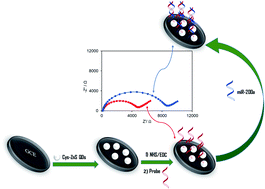Femtomolar determination of an ovarian cancer biomarker (miR-200a) in blood plasma using a label free electrochemical biosensor based on l-cysteine functionalized ZnS quantum dots†
Abstract
In the present study, a label-free electrochemical genosensor was designed based on ZnS quantum dots functionalized with L-cysteine (Cys–ZnS-QDs) to detect miR-200a, as a special ovarian cancer biomarker. The Cys–ZnS-QD genosensor was characterized by transmission electron microscopy (TEM), UV-Vis absorption and fluorescence methods. Cys–ZnS-QDs are electrodeposited on the glassy carbon electrode surface and act as a suitable substrate for immobilization of the DNA probe. The effective parameters in the preparation of the genosensor are optimized to improve its analytical performance. The analytical performance of the genosensor has been investigated using electrochemical impedance spectroscopy. Under optimal conditions, the linear range and the detection limit of miR-200a were found to be 1.0 × 10−14 to 1.0 × 10−6 M and 8.4 fM. In addition, the genosensor is used to detect the target complementary miRNA strand from a single-base mismatch miRNA strand. Finally, this label-free electrochemical biosensor was used to detect miR-200a in human plasma without using any amplification method.



 Please wait while we load your content...
Please wait while we load your content...